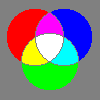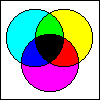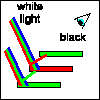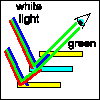 CRT Monitor - The commonest visual display unit (VDU) used
by desktop computers today. It is similar to a TV but has no UHF receiver. For the scientists amongst you
- it uses a cathode ray tube (CRT) to fire electrons at a
coating of very tiny phosphor dots on the inside of the screen.
This causes the dots to glow. A red, green and blue
(RGB) dot makes up a pixel of visible light. By
varying the intensity of each of these primary colours, the whole
pixel will appear to the human eye as any colour desired.
CRT Monitor - The commonest visual display unit (VDU) used
by desktop computers today. It is similar to a TV but has no UHF receiver. For the scientists amongst you
- it uses a cathode ray tube (CRT) to fire electrons at a
coating of very tiny phosphor dots on the inside of the screen.
This causes the dots to glow. A red, green and blue
(RGB) dot makes up a pixel of visible light. By
varying the intensity of each of these primary colours, the whole
pixel will appear to the human eye as any colour desired.
 |
This
is one RGB pixel of light R + B = M (magenta)
B + G = C (cyan)
G + R = Y (yellow)
R +
G + B = W (white)
|
The more
dense the pixels the greater is the clarity, or resolution,
of the screen image.
- VGA (Video
Graphics Array) = 640 x 480 pixels
- SVGA (Super
Video Graphics Array) = 800 x 600 pixels
- XGA (Extended
Graphics Array) = 1024 x 768 pixels
 LCD Monitor
- smaller, lighter and using much less power than a normal CRT monitor makes them ideal for portable lap-top computers. Also
used in watches and calculators. For the scientists amongst you this is all to
do with the polarisation of light by an electromagnetic field applied to a
crystal which produces a liquid crystal display (LCD). These screens are rapidly
replacing CRT both for computers and for home television.
LCD Monitor
- smaller, lighter and using much less power than a normal CRT monitor makes them ideal for portable lap-top computers. Also
used in watches and calculators. For the scientists amongst you this is all to
do with the polarisation of light by an electromagnetic field applied to a
crystal which produces a liquid crystal display (LCD). These screens are rapidly
replacing CRT both for computers and for home television.
 Daisy-Wheel
Printer -
like a typewriter but with the preformed letters on the ends of
spokes to form a wheel. The letters strike an inked ribbon onto
paper. Good (typewriter quality) resolution. Very slow - ½ ppm (page
per minute). Very noisy. Can only print the characters provided
on the wheel and no graphics (line drawings, pictures). One
colour (monochrome) only. PROBABLY NO LONGER IN USE.
Daisy-Wheel
Printer -
like a typewriter but with the preformed letters on the ends of
spokes to form a wheel. The letters strike an inked ribbon onto
paper. Good (typewriter quality) resolution. Very slow - ½ ppm (page
per minute). Very noisy. Can only print the characters provided
on the wheel and no graphics (line drawings, pictures). One
colour (monochrome) only. PROBABLY NO LONGER IN USE.
 Dot-Matrix
Printer -
a set of steel pins strike an inked ribbon onto paper producing any desired
sequence of dots. Low resolution - 72 dpi (dots per inch) - can
just see the dots. Quite fast - 1 ppm. Slightly noisy. Can print any shape of
character (font) stored in the computer memory and any graphics, all on the same
page. PROBABLY NO LONGER IN USE.
Dot-Matrix
Printer -
a set of steel pins strike an inked ribbon onto paper producing any desired
sequence of dots. Low resolution - 72 dpi (dots per inch) - can
just see the dots. Quite fast - 1 ppm. Slightly noisy. Can print any shape of
character (font) stored in the computer memory and any graphics, all on the same
page. PROBABLY NO LONGER IN USE.
 Ink-Jet
Printer
- fires a jet of liquid ink through tiny holes. High resolution -
300 to 600 dpi for almost professional quality, sharp printing.
Fast - 3 ppm. Very quiet. Cost around £100. Full black and
colour print on same page. Thousands of colours are created by
mixing tiny dots of cyan, magenta and yellow
(CMY) ink on the paper. Replacement ink cartridges for each
colour cost around £10-25. Better printers have separate black, cyan, magenta
and yellow cartridges for more economical replacement when empty.
Ink-Jet
Printer
- fires a jet of liquid ink through tiny holes. High resolution -
300 to 600 dpi for almost professional quality, sharp printing.
Fast - 3 ppm. Very quiet. Cost around £100. Full black and
colour print on same page. Thousands of colours are created by
mixing tiny dots of cyan, magenta and yellow
(CMY) ink on the paper. Replacement ink cartridges for each
colour cost around £10-25. Better printers have separate black, cyan, magenta
and yellow cartridges for more economical replacement when empty.
 |
This
is one CMY pixel of ink C + M = B (blue)
M + Y = R (red)
Y + C = G (green)
C +
M + Y = B (black)
|
Photographic quality printers can have even more colours to mix for greater
accuracy.
Why not use red, green and
blue ink?
 Laser
Printer - works like a photocopier, powdered ink is fused
onto paper by heat and pressure. Very high resolution - 600 to
1200 dpi for full professional quality. Very fast: 6 -16 ppm for
multiple copies. Almost silent. Cost around £100. Replacement
black 'toner' cartridges cost around £50 but last a long time and much more
economical than ink-jet printing. Colour laser printers are
more expensive at around £250 with £50 for each of 4 replacement cartridges but
still cheaper to run than colour
inkjet printers.
Laser
Printer - works like a photocopier, powdered ink is fused
onto paper by heat and pressure. Very high resolution - 600 to
1200 dpi for full professional quality. Very fast: 6 -16 ppm for
multiple copies. Almost silent. Cost around £100. Replacement
black 'toner' cartridges cost around £50 but last a long time and much more
economical than ink-jet printing. Colour laser printers are
more expensive at around £250 with £50 for each of 4 replacement cartridges but
still cheaper to run than colour
inkjet printers.
 Braille
Printer - by converting text into the Braille code, this
printer produces patterns of raised dots on paper for use by the
blind.
Braille
Printer - by converting text into the Braille code, this
printer produces patterns of raised dots on paper for use by the
blind.
 Graphics
Plotter - uses high precision motors controlled by the
computer to draw on paper with coloured ink pens. Used for
drawings where a high degree of accuracy is required such as
building plans, printed circuit boards and machine parts.
Graphics
Plotter - uses high precision motors controlled by the
computer to draw on paper with coloured ink pens. Used for
drawings where a high degree of accuracy is required such as
building plans, printed circuit boards and machine parts.
 Speaker
- for music or speech from programs, CD-ROMs and musical
instruments.
Speaker
- for music or speech from programs, CD-ROMs and musical
instruments.
 Light-Emitting
Diode (LED) - small low power devices which emit light. Used
to indicate various events such as power on or hard disk in
operation and to monitor other control applications.
Light-Emitting
Diode (LED) - small low power devices which emit light. Used
to indicate various events such as power on or hard disk in
operation and to monitor other control applications.
 Relay
switches & motors - a computer can be programmed very
easily to turn switches on and off at the required times. For
example to control traffic lights or electric motors in a robot
arm. Used in the automobile industry to spray body shells or to
assemble and weld parts together; or to assemble delicate
electronic components on a printed-circuit board for computers,
radios and almost anything else you can think of.
Relay
switches & motors - a computer can be programmed very
easily to turn switches on and off at the required times. For
example to control traffic lights or electric motors in a robot
arm. Used in the automobile industry to spray body shells or to
assemble and weld parts together; or to assemble delicate
electronic components on a printed-circuit board for computers,
radios and almost anything else you can think of.
This is for the scientifically minded
only:
Question:
Why doesn't the printer use the three primary colours: red, green
and blue?
 Answer:
Green ink appears green because when white light (W = R+G+B) is
shining on it, it absorbs the red and blue, and reflects the
remaining green light to our eyes (W-B-R = G). Similarly, red ink
absorbs the green and blue, and reflects red light (W-B-G = R).
Therefore, if we mix red and green inks then all three colours
are absorbed by the mixture, no light is reflected and it will
appear black: R+G = W-B-G + W-B-R = W-B-G-R = W-W (black). The
same will happen with any combination of these three primary
colours, so no ink colours can be made with them at all.
Answer:
Green ink appears green because when white light (W = R+G+B) is
shining on it, it absorbs the red and blue, and reflects the
remaining green light to our eyes (W-B-R = G). Similarly, red ink
absorbs the green and blue, and reflects red light (W-B-G = R).
Therefore, if we mix red and green inks then all three colours
are absorbed by the mixture, no light is reflected and it will
appear black: R+G = W-B-G + W-B-R = W-B-G-R = W-W (black). The
same will happen with any combination of these three primary
colours, so no ink colours can be made with them at all.
Question:
Why does the printer use the three secondary colours: cyan,
magenta and yellow?
 Answer: Yellow
ink appears yellow because when white light (W = R+G+B) is
shining on it, it absorbs the blue and reflects red and green
light which we see as yellow (Y = W-B). Cyan ink absorbs red and
reflects blue and green which we see as cyan (C = W-R). Therefore,
if we mix yellow and cyan inks then both red and blue light are
absorbed by the mixture, and green is reflected - it will appear
green: Y+C = W-B + W-R = W-B-R = G (green). Any combination of
the three secondary colours (CMY) will produce one of the primary
colours (RGB). Varying the amount of each coloured ink will
produce all the colours possible.
Answer: Yellow
ink appears yellow because when white light (W = R+G+B) is
shining on it, it absorbs the blue and reflects red and green
light which we see as yellow (Y = W-B). Cyan ink absorbs red and
reflects blue and green which we see as cyan (C = W-R). Therefore,
if we mix yellow and cyan inks then both red and blue light are
absorbed by the mixture, and green is reflected - it will appear
green: Y+C = W-B + W-R = W-B-R = G (green). Any combination of
the three secondary colours (CMY) will produce one of the primary
colours (RGB). Varying the amount of each coloured ink will
produce all the colours possible.

 Information & Communication Technology 1996-2003
Information & Communication Technology 1996-2003
 Information & Communication Technology 1996-2003
Information & Communication Technology 1996-2003